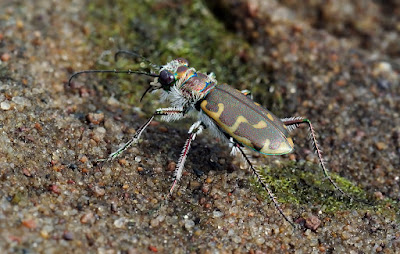"The problem is not scientifically illiterate kids; it is scientifically illiterate adults. Kids are born curious about the natural world. They are always turning over rocks, jumping with two feet into mud puddles and playing with the tablecloth and fine china."
― Neil deGrasse Tyson
Hairy-necked Tiger Beetles (Cicindela hirticollis) have been hard to come by the past few years at the Sauk Canoe Launch, so I was grateful that Mark Johnson found four of them at another location along the Wisconsin River this past weekend. I didn't get his message until it was too late to make the trip, so I took the day off today to see them ― and take a lot of photographs!
Hairy-necked Tiger Beetles seem to prefer wet sand and mud right along the water's edge. Navigating across the sandbar, I stumbled upon Allegheny Monkeyflower ― a common rhizomatous wetland flower found by streams and rivers throughout Wisconsin. Nifty plant, but my singular focus was on finding the beetles.
So that didn't take long ...
Look at all the beach flies ― these tiger beetles have plenty to eat. I had forgotten just how annoyingly fast and skittish Hairy-necked can be. My regular approach wasn't working out so well, so I had to adjust and come in even slower and lower.
Naturally, I like getting the front-angle view of tiger beetles, but these bugs weren't having it. As soon as I would get into position, they would turn and face the other direction. Their large bulging eyes give them the ability to see behind them ― the position adjustment is made for a pending escape flight.
Note the difference between the thickness of the middle maculations ― definitely two different individuals. To identify Hairy-necked from other similar species, the front maculation has a "G" shape instead of a "C" or "J" as other species show.
Not copulating, this male is mate guarding ― no genitalia visible.
Finally! Here's a somewhat cooperative individual that tolerated a variety of angles. The slight difference in maculation color may be an age related feature. Most individuals present were the chocolate-brown color with off-white maculations, whereas this particular beetle's were more of a yellowish tone. Just look at the size of those sickle-shaped mandibles!
Finally! Here's a somewhat cooperative individual that tolerated a variety of angles. The slight difference in maculation color may be an age related feature. Most individuals present were the chocolate-brown color with off-white maculations, whereas this particular beetle's were more of a yellowish tone. Just look at the size of those sickle-shaped mandibles!
These are two different Eastern Tiger Swallowtails ― can you spot the differences? I saw a Giant Swallowtail on the beach as well, but it couldn't settle on a spot on the wet sand to extract nutrients.
Told ya I got plenty dirty.
A very successful outing! I also found Sandy Stream Tiger Beetles at this particular spot, making three different locations along the Wisconsin River where I can find them now. Given the relatively short distances from these three locations, my hunch is that they're probably quite common along the Wisconsin River, from Sauk City on down. I think what I would like to do is kayak down the river and explore more of the sandbars that are inaccessible from roads and trails.
All images © 2022 Mike McDowell
























